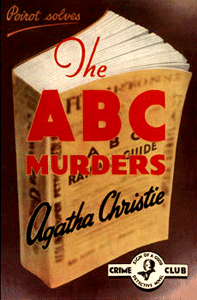Poirot and Hastings started off as equivalents of Arthur Conan Doyle’s Holmes and Watson, but Agatha Christie wasn’t interested in giving Poirot a Moriarty equivalent. Perhaps the closest she comes is “The A.B.C. Murders” (1936).
Order and method … for evil
The antagonist uses Poirot-style order and method for villainous means. The villain kills alphabetically – Alice Ascher in Andover, Betty Barnard in Bexhill, etc. He leaves an A.B.C. railway guide – with its neat charts of departures and arrivals — at each murder. He types letters to Poirot, singling him out as a rival where the murders are (seemingly) only for the purpose of “the game.”
This is one of several things that makes “A.B.C. Murders” stand out as an elite Christie work. Another is that we’re dealing with a serial killer, a first for Poirot and Hastings. As Poirot says in chapter 14:

“The A.B.C. Murders” (1936)
Also published as: “The Alphabet Murders”
Author: Agatha Christie
Genre: Serial killer mystery
Series: Hercule Poirot No. 12
Setting: England railway towns, 1936
“Always, up to now, it has fallen our lot to work from the inside. It has been the history of the victim that was important. The important points have been: ‘Who benefited from the death? What opportunities had those round him to commit the crime?’ It has always been ‘crime intime.’ Here, for the first time in our association, it is cold-blooded, impersonal murder. Murder from the outside.”
In reality, serial killers are rare. In the vast majority of murders, the killer and victim are acquainted. If you don’t have enemies, odds are you are safe from being murdered, even in this scary world. Stories – and true-crime podcasts — about serial killers come in far greater proportions than their natural occurrences. Christie kept her fiction proportional to reality.
That’s part of why “A.B.C. Murders” is beloved as a unique Christie effort.
Criminal intent?
I’d also note that it’s a supremely good character piece. Although the killer chooses targets impersonally, we do get to know the victims and the people around them. Indeed, friends and family of victims A, B and C form a sort of crime club – with Poirot’s blessing — to stop future killings.
In a seeming parallel to what “Law & Order: Criminal Intent” would do, we cut away to the (presumed) killer, Alexander Bonaparte Cust. (Except for the Cust chapters, Hastings does the narrating.) He’s a well-developed character, suffering from outsider status and self-loathing.
When Poirot interviews him in his jail cell, Cust describes being bullied in school, but contends that he deserved it. Christie pulls off a trick wherein accounts of Cust’s behavior paint him as the murderer, yet he might not be. After all, it’d be unusual for a mystery to tell us who the murderer is from the start. (That’s another thing Christie didn’t do, but nor did we want her to.)
Framing the plot (Spoilers)
One final reason for the book’s greatness requires me to post a SPOILER WARNING.

“A.B.C.” illustrates how frighteningly easy a frame job on a mentally ill person could be to pull off, if the framer is supremely dedicated, as is the case with Franklin Clarke. Being mentally ill, Cust would end up in a cage for life if Poirot wasn’t working this case. (No one else remotely suspects Cust is being framed, and indeed, they think Poirot himself is mentally ill for suggesting it.)
Poirot points out that being locked up is a worse fate than being killed by the state. It’s an unusual view, but one I hold. (I think imprisonment violates the Eighth Amendment, but unfortunately “cruel and unusual” are open to interpretation – this is a prime example of the Founders using language that can be easily manipulated.)
I was thrilled to find out Poirot somewhat agrees with me. (His encouragement that murderers in two previous books commit suicide rather than go to court further suggests his resistance to the principle of imprisonment.)
Cust is Christie’s most famous example of an innocent person thinking they are a murderer. She goes to this well too often compared to the odds of it happening in reality. But Cust and his epileptic condition are so well-developed that it’s plausible. More so than, certainly, the framed person in “The Third Girl” who is addled by “drugs.”
Laying the trap (Spoilers)
Another interesting point about Poirot’s outing of Clarke: He baits him with untrue “evidence” that his fingerprints were on the typewriter. Clarke confesses at that point and the police enter from the next room to arrest him. Would the confession hold up in court, since Poirot lied in order to get it?
“A.B.C.” ends before we get to that point, which is a mild shame. But until then, it’s one engrossing chapter after another, with Poirot and Hastings in vintage form yet working a case unlike any other.
The alphabetical element seems contrived only at first blush; once the action begins, Christie conjures that delicious widespread fear of a madman on the loose. We imagine that, off page, Dorchester residents whose names start with “D” are petrified. And people whose names start with “E” and live in “E” towns are getting worried.
“The A.B.C. Murders” is brilliantly plotted on two levels – both what is supposedly happening (if Cust was the killer) and what’s really happening (with Clarke being the killer and framing Cust). This novel required more logistical thought than average, but Christie makes it look as easy as A.B.C.
Sleuthing Sunday reviews an Agatha Christie book or adaptation. Click here to visit our Agatha Christie Zone.

